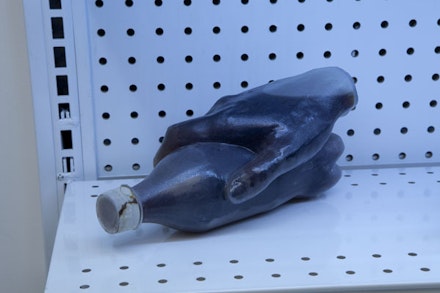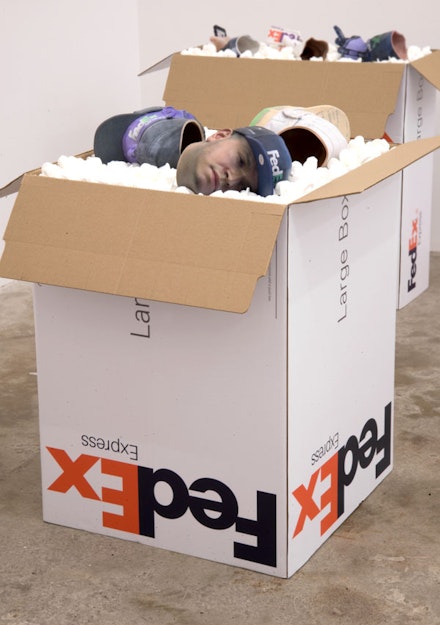JOSH KLINE lives and works in New York. His work has been included in exhibitions at MoMA PS1, White Columns, 47 Canal, Murray Guy, Marianne Boesky, PERFORMA, and Gavin Brown’s Enterprise, among others in New York; Kunsthalle Fridericianum, Kassel; Night Gallery, Los Angeles; ICA Philadelphia, Schirn Kunstahalle, Frankfurt; and Castillo/Corrales, Paris. In 2015 his work will be included in the New Museum Triennial curated by Lauren Cornell and Ryan Trecartin and present a solo exhibition at Modern Art Oxford in the UK. As a curator, Kline has organized exhibitions at venues including MoMA PS1, Andrea Rosen Gallery, Gresham’s Ghost, Old Room, 179 Canal, and Canada Gallery in New York. His work has been written about in publications including Artforum, Frieze, the New York Times, Frankfurter Allgemeinezeitung, Mousse, and the New Yorker.
What new or old tools are you
attached to in your art practice?
When choosing tools, I sometimes evaluate their usefulness based on their relationship to the time I’m describing in the work. Sometimes a tool’s “newness” or level of novelty becomes essential in depicting where certain subjects and phenomena are in the present, have been in the recent past, and are going in the future. The “newer” or more surprising something feels, the more likely that it’s a marker of the moment in time we inhabit or are about to inhabit. A still-breathing period piece.

For instance, outside of industrial design and architecture offices, 3D printing is a much hyped, but currently useless, technology. 2015’s home 3D printer is good for making knickknacks and simple plastic toys and not much else. That said, using the more advanced full-color or multi-material rapid prototyping machines to create what are essentially solid images points towards probable futures: the eventual supersession of gray-ink, sprocket-hole, dot-matrix printers by machines that can print family photos on cheap supermarket ice-cream cakes; digital C-prints. More powerful industrial technology is waiting in the wings.
I’m interested in any kind of tool that can be used for sampling, and also in tools that can alter, composite, and export sampled content and subjects. Sometimes sampling means a cotton swab and a ziplock bag, other times it means a camera. Over the last couple of years, I’ve become obsessed with devices that can produce biometric 3D scans—including laser scanners, digital cameras, and associated software. In 2014, I started doing 3D scans with DSLR cameras, which opens up a whole new world of solid photography. Primitive daguerreotype holograms. The way they’re created—by compositing together scores of photos of a subject taken from different perspectives—becomes a metaphor for how information about us is collected by companies and government agencies. Fractured aspects of our lives accumulating in different databases, creating subtly different portraits. Cameras can now be used to take actual physical measurements of subjects. Along with light and shadow, they now capture a person’s height and the three-dimensional topography of their various physical features.
Whether I’m working with 3D models, video, images, or text, the computer is the real tool. At this point, this is true for most artists—even the painters. The computer has become the true studio. Inside hacked and pirated commercial design software, sampled material is combined in new and more complex forms of irrational language. The results are then exported as videos, images, objects, and other kinds of experiences. This mirrors the way that most people in the world’s networked societies now communicate—using smartphones to sample their environment and then speaking to their friends/audiences in bursts of images and video.
What tools have you rejected?
When people ask me what media I work in, my long-running joke is that I work in every medium except paint. And even with paint—I don’t rule out returning to it in the years ahead if it helps me communicate more effectively at that specific point in time. Different media are more appropriate in different eras. For instance, the early 2000s was a time defined by cartoon-inspired drawing, graffiti-inspired skater art, and point-and-shoot lifestyle/street photography. Today, in spite of the high visibility of speculative abstract painting, we’re probably in a sculpture moment.

The art world keeps most painters in an art-history holding cell. It’s extremely difficult for paintings to escape from a self-reflexive post-AbEx conversation about formal/historical issues—a circular conversation about brush strokes, mark-making, and the structuring of abstraction. “Indexicality.” With a few very notable (and very brilliant) exceptions, contemporary painting is also not very good at speaking with people outside of art. As a general rule, the artists who embrace it generally have the least interest in engaging with non-art audiences through their work. In the West, we process and understand the world through digital images, brands, and products. Why paint a picture of them, when you can just use the real thing?
What have the tools
done to your art?
I’ve come to see photography, image compositing, video, 3D animation, sculpture, etc., as aspects of a single amorphous medium. Formally, much of my work has become about exploring what it means for all of these media to become aspects of or moments in a non-linear production process. “Digitization” sounds boring, but it’s a large percentage of human activity in the “developed” world now. Typing text, scanning documents, recording someone on video—it’s all information being digitized. Shopping on Amazon.com with a credit card, filling out forms at the doctor’s office, buying groceries, applying for a job: human lives being digitized. In the work I’ve made since 2013, I’ve consciously tried to approach these processes as a medium. Information or actual material is sampled from various living and non-living subjects, augmented or composited with other sampled materials and then exported as video, sculpture, images, or working material for other art. Much of my work deals with labor and the human condition—how these phenomena are being affected by technology. This way of working—approaching work from all conceivable directions—also mirrors the way we are expected to perform in the workplace (which has in turn expanded to become every waking moment of our entire life).